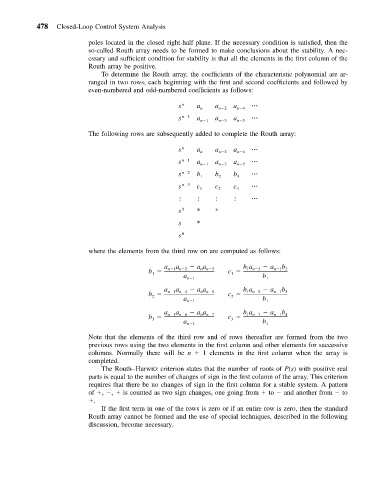Page 487 - Mechanical Engineers' Handbook (Volume 2)
P. 487
478 Closed-Loop Control System Analysis
poles located in the closed right-half plane. If the necessary condition is satisfied, then the
so-called Routh array needs to be formed to make conclusions about the stability. A nec-
essary and sufficient condition for stability is that all the elements in the first column of the
Routh array be positive.
To determine the Routh array, the coefficients of the characteristic polynomial are ar-
ranged in two rows, each beginning with the first and second coefficients and followed by
even-numbered and odd-numbered coefficients as follows:
s n a n a n 2 a n 4
s n 1 a n 1 a n 3 a n 5
The following rows are subsequently added to complete the Routh array:
s n a a a
n n 2 n 4
s n 1 a a a
n 1 n 3 n 5
s n 2 b b b
1 2 3
s n 3 c c c
1 2 3
s 2 * *
s *
s 0
where the elements from the third row on are computed as follows:
a a aa ba a b
b n 1 n 2 nn 3 c 1 n 3 n 12
1
1
a n 1 b 1
a a aa ba a b
b n 1 n 4 nn 5 c 1 n 5 n 13
2
2
a n 1 b 1
a a aa ba a b
b n 1 n 6 nn 7 c 1 n 7 n 14
3 3
a n 1 b 1
Note that the elements of the third row and of rows thereafter are formed from the two
previous rows using the two elements in the first column and other elements for successive
columns. Normally there will be n 1 elements in the first column when the array is
completed.
The Routh–Hurwitz criterion states that the number of roots of P(s) with positive real
parts is equal to the number of changes of sign in the first column of the array. This criterion
requires that there be no changes of sign in the first column for a stable system. A pattern
of , , is counted as two sign changes, one going from to and another from to
.
If the first term in one of the rows is zero or if an entire row is zero, then the standard
Routh array cannot be formed and the use of special techniques, described in the following
discussion, become necessary.

